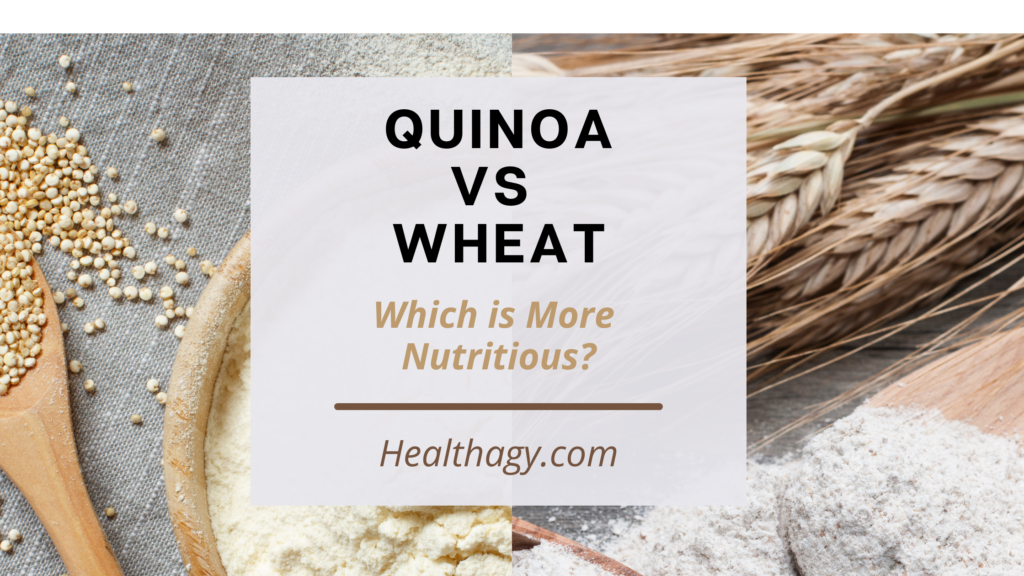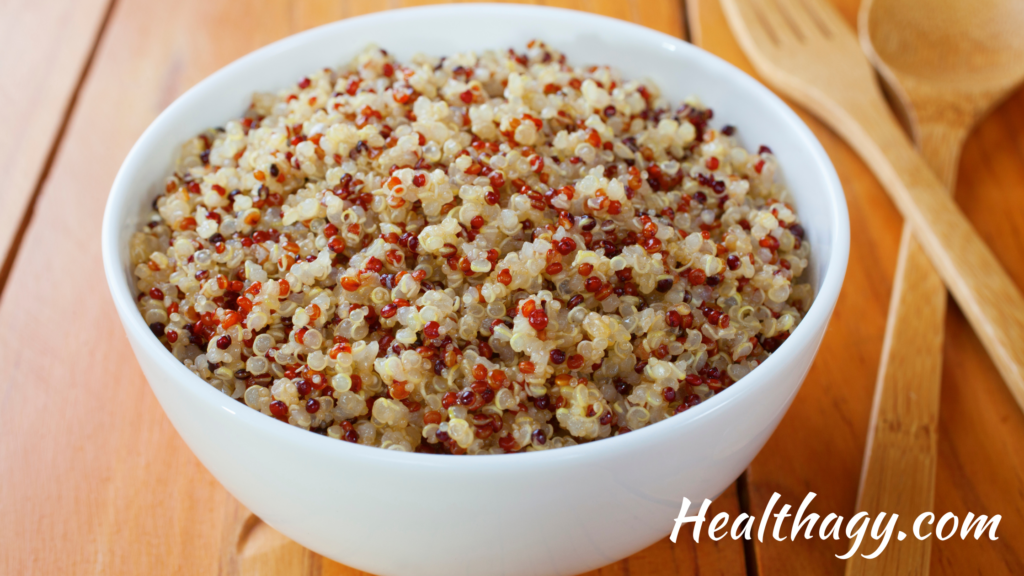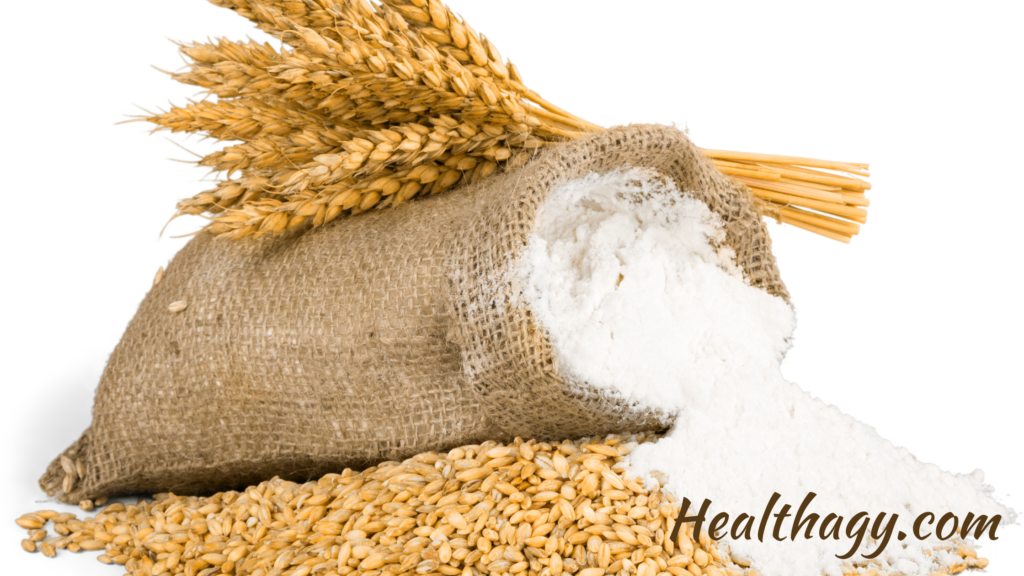
Quinoa has become a favorite wheat alternative for those with celiac disease and those on a gluten-free diet. But what about people who can tolerate gluten and wheat products? Which grain is superior, offering more nutritional value? Quinoa or wheat?
This post will cover all this and more! Find out which of these grains offers the most nutrition and health benefits.
Key Differences Quinoa vs Wheat
The main difference between quinoa vs wheat is that quinoa is gluten-free and suitable for those on a gluten-free diet. Wheat contains gluten and should not be eaten by anyone avoiding gluten.
Quinoa has more nutritional value than refined wheat or white wheat products, as quinoa is a whole grain. However, when it comes to quinoa vs whole wheat, the nutritional values are similar.
| Quinoa Flour | Refined/White Wheat Flour (All-purpose flour) | Whole Wheat Flour | |
| Gluten-Free | Yes | No | No |
| Whole Grain | Yes | No | Yes |
| Calories per 100 g | 393 | 364 | 355 |
| Protein per 100 g | 14.3 g | 10.3 g | 12.9 g |
| Complete Source of Protein | Yes | No | No |
| Naturally Occurring vs Enriched Vitamins & Minerals | Naturally Occurring | Enriched | Naturally Occurring |

What is Quinoa?
Quinoa is an ancient grain that has been around for centuries. While it is technically a seed, quinoa seeds nutritionally act like a grain, so they are called a pseudo-grain. Quinoa is full of fiber, protein, and other vitamins and minerals. One thing that has made quinoa popular among people eating a plant-based diet is that quinoa is one of the few plant sources of protein that qualifies as a complete protein source, which means it contains significant amounts of all nine essential amino acids.
Quinoa has a slightly nutty but relatively bland taste. It can be found in a few varieties, such as red quinoa and black quinoa, the most common being white quinoa. Quinoa is similar in many ways to brown rice and is a great alternative to rice as they are both whole grains with a bland taste, with the bonus that quinoa is a complete protein source while brown and white rice is not.
Because quinoa is gluten-free, inexpensive, and a great source of protein, it has become a popular staple food among and one of the most popular gluten-free grains among health enthusiasts and those on a gluten-free diet. Quinoa can also be ground into quinoa flour and is a great option for gluten-free flour in baking. You may also find other foods made from quinoa flour, such as quinoa pasta and quinoa flakes.
Although some consider quinoa a newer food in America, it has become a fairly common food and is readily available at most grocery stores. If you are on a strict gluten-free diet, don’t forget to look for the certified gluten-free stamp when buying quinoa.

What is Wheat?
Wheat is one of the most common cereal grains in America and many places throughout the globe. It is a member of the grass family and is used to make wheat flour, the main ingredient in most bread, pasties, snacks, and breakfast cereals.
There are two main types of wheat flour, whole grain flour, and white flour. There are several varieties of wheat, they are primarily categorized by their growing season spring wheat and winter wheat- which is the leading wheat grown in the U.S. Wheat is then further classified by the hardness, color, and shape of its kernel, which results in hard red winter wheat, hard red spring wheat, soft red winter wheat, durum wheat- commonly used in pasta, hard white wheat and soft white wheat.
The protein content of the wheat determines what type of wheat is used in baking. Most flours are refined, bleached, and enriched, so their natural nutritional values are compromised or lost and artificially enriched with nutrients. Most at-home bakers use an all-purpose flour comprising 80% hard wheat and 20% soft wheat.
Whole wheat is the least processed wheat flour, retaining most of the nutritional value during the milling process. Whole wheat is the better choice nutritionally between refined white wheat flour and whole wheat flour.
Quinoa vs Wheat Nutrition
To compare, we’ll look at the key nutritional values of 100 grams each of quinoa flour to all-purpose wheat flour. For reference, one cup of quinoa flour would equal about 112 grams, and one cup of all-purpose wheat flour is about 125 grams.
| Quinoa Flour (100g), %Daily Value | All Purpose Wheat Flour (100g), %Daily Value | Whole Wheat Flour (100 g) % Daily Value | |
| Calories | 393 | 364 | 355 |
| Total Carbohydrate -Dietary fiber -Sugar | 64.3 g, 21% 7.1 g, 25% 0 g | 76.3 g, 25% 2.7 g, 10% 0.3 g, 1% | 67.7 g, 23% 9.7 g, 35% 0 g, % |
| Protein | 14.3 g, 29% | 10.3 g, 21% | 12.9 g, 26% |
| Total Fat Saturated Fat | 7.1 g, 9% 0 g, 0% | 1 g, 1% 0.2 g, 1% | 3.2 g, 4% 0 g, 0% |
| Vitamin D | 0 mcg | 0 mcg | 0 mcg |
| Calcium | 36 mg, 3% | 15 mg, 1% | 0 mg, 0% |
| Iron | 4.5 mg, 25% | 4.6 mg, 26% | 3.5 mg, 19% |
| Potassium | 172 mg, 4% | 107 mg, 2% |
Quinoa has a low glycemic index, around 53. Whole wheat, such as whole wheat bread, is slightly higher, about 56-59, considered moderate—foods with a lower glycemic index help to regulate blood sugar levels better. White wheat has a high glycemic load. Quinoa is the best choice for people with diabetes and anyone with blood sugar issues.
Is Quinoa or Wheat Healthier?
Whole grains are always a healthier choice than refined grains, so quinoa and whole wheat foods are healthier and have more nutritional benefits than white flour or refined grain foods, as they are fortified nutrients after having naturally occurring nutrients stripped away during the refining process.
Whole grain wheat and whole grain quinoa both have a high fiber content. Both are also good sources of vitamin B, specifically B2. Overall, quinoa contains more b vitamins, though. It also has more iron, zinc, and calcium than wheat. They both also include various other vitamins and minerals, but quinoa does contain more vitamins, including vitamin C, vitamin A, and vitamin E.
When it comes to whole wheat vs quinoa, they both have a high protein content, with quinoa flour having 14.3 grams of protein per 100-gram serving and whole wheat flour having 12.9 grams of protein. Quinoa makes a great side dish or can be added to a salad or any dish as a rice alternative, which makes it a versatile food.
Quinoa is also a good source of healthy fats, mostly unsaturated fatty acids. Fats help us to digest fat-soluble vitamins, maintain healthy cellular functioning and support digestive enzymes. Fats also take longer to digest, which can help you feel fuller for longer and may support weight loss.
People eating a standard American diet tend to consume many wheat products, so rotating in new whole grains is always a good option.
When it comes down to it, in terms of nutrition, quinoa is a better choice than whole grain wheat.
Read More:
How Long Does Cooked Quinoa Last?
Karla Kueber is a Certified Evidence Based EFT Practioner and Health Coach, with a double Masters Degree in Education. She works with people to overcome emotional eating, curb cravings, and overcome resistance to eating new healthy foods. You can learn more about coaching with her here.